Palestinian currency history
"Do Not Touch the Currency!" was the unequivocal ruling of one of the senior officials in the Mandatory government of 1921 when the plan for the introduction of a new currency to Palestine was presented to him (Hoofien, S. Currency Reform, Palestine Economic Society, 1923).
This statement well reflected the reluctance, particularly of the British Colonial Office, to deal with the topic of reform, at the centre of which was the issuing of currency notes for Palestine. Indeed, it took ten years following the original proposal to issue a local currency on November 1, 1927. The original suggestion had been put forward by the Anglo-Palestine Company in October 1917 but was rejected by the British government on political grounds for fear that it might appear one-sided vis-a-vis the Arab population.
What is fascinating is not only the details of the discussions regarding the reform and the unraveling of events, but the fact that the currency notes of Palestine, ostensibly merely a form of payment, have always played a central role in extraordinary events.
The first of these was in May 1917 when Ahmed Jamal Pasha, commander of the Fourth Army and governor of Syria and Palestine, declared the penalty of deportation as a means of punishing those found guilty of refusing to accept Turkish government treasury notes as a means of payment, or for redeeming them at less than their face value.
The Egyptian pound became legal tender in Palestine beginning January 1918, and won the complete confidence of the public, which raises the following, key question. Why, after almost ten years of monetary stability, did the British government decide to create a new currency for Palestine?
In fact, the answer, as presented by the Colonial Office, was purely economic. At the time, the profits resulting from trading in the Egyptian pound were benefitting the Egyptian government and the National Bank of Egypt. The introduction of a currency unique to Palestine would lead to a situation in which the resulting profits would benefit the Government of Palestine.
Interestingly, this argument was first raised in 1927 around the time of the currency’s introduction into circulation, prior to which there had been no interest in this essential issue, not even on the part of the various currency committees that had convened between 1919 - 1925.
In November 1927, the first notes ever to be issued specifically for Palestine entered into circulation, but despite their historical significance, their appearance immediately caused an uproar among all sectors of the public. The Jewish population expressed its disappointment that the notes did not fulfill their symbolic and historic purpose; the Christians complained that they were not represented in the illustrations on the notes; the Arab press, across-the-board, complained that the notes, as they were issued, were an insult to the Arab population. Arab dignitaries in Jaffa called on the population to boycott them and leave their funds in Egyptian currency.
Even after the storm abated and the new notes were already in circulation, they led to other extraordinary events, including:
- protracted discussions that took place over a ten-year period regarding new designs;
- preparations for local emergency printing due to the cutting-off of supply lines from Britain during WWII;
- declaration of the notes as legal tender in Cyprus, an emergency measure during WWII;
- counterfeiting by underground organizations.
Ultimately, in 1948, history would have it that the notes of the Currency Board entered circulation in three politically-divided areas, Israel, Trans-Jordan, and the Gaza Strip, which in a short time found themselves at war.
Although within less than fifty years of their original issue the Palestine currency notes dropped out of use, they remain fascinating in their uniqueness and in the historical monetary role that they played.
Today, there are dozens of collectors of these notes, and collection specialties vary. Some collect by denomination, some by date, some by the prefixes on all the series of all the denominations and all the dates.
MONETARY BACKGROUND
The numismatic history of Palestine dates back to the fourth century B.C.E., with the minting of the first coins, issued in Persian-dominated Judea, known as the province of Yahad.
The history of paper money in Palestine began some 2300 years after the minting of these first coins, during the WWI, with the local and unofficial issue of paper tokens and cheques. Although these notes were not actual banknotes, they are a cornerstone in the numismatic history of Palestine.
APC cheques for payment at set denominations of 20 francs of the first and second series and that of the Safed branch series
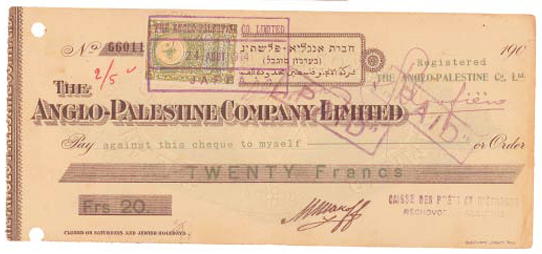
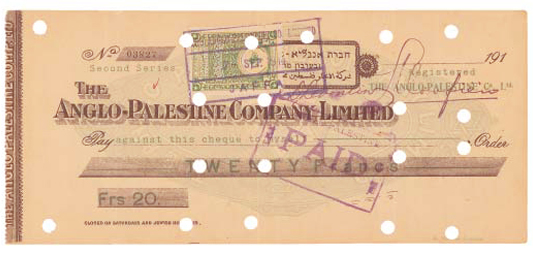
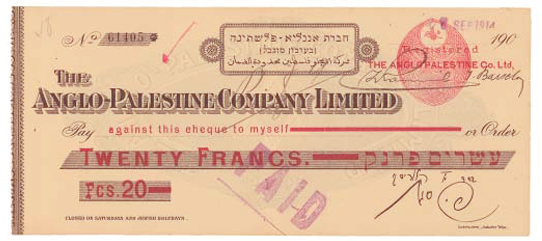
Tel Aviv Committee paper payment tokens of one beslik
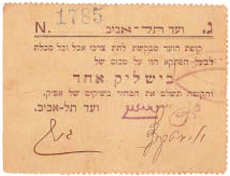
Tel Aviv Committee paper payment tokens of one franc
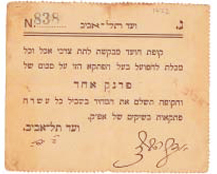
THE BIRTH OF THE CURRENCY OF PALESTINE
The idea of issuing a unique currency for Palestine, and particularly paper money, was proposed as early as 1917 by the Anglo-Palestine Company (APC), and between 1917-1923, the topic was discussed no less than five times. Most of the proposals and discussions pertained to the issue of banknotes, which related to the problem of currency as a whole.
- Proposal of the APC to issue banknotes (1917-1918)
- The Advisory Financial Committee (1919)
- Proposal of Sir Herbert Samuel regarding the question of currency in Palestine (1920)
- The political committee on the matter of the coins of Palestine (1920)
- Finalization of a plan for currency in Palestine by the APC (1921-1923).
The first suggestion was proposed at the end of WWI, while the others came under discussion by virtue of necessity created by the post-war state of affairs.
The second, third and fourth proposals were initiated by officials in the British administration. The fifth proposal was initiated by the APC.
Between 1924 -1925, the Currency Committees convened. Their work laid the foundations for the Palestine Currency Board, the body that ultimately issued currency notes for Palestine.
PREPARING FOR THE INTRODUCTION OF THE NEW CURRENCY
The preparations for the introduction of the new currency began in 1926, and were carried out in two stages:
- establishment of the Palestine Currency Board, through the appointment of members by the Secretary of State for the Colonies, setting up of orders to create a formal, legal context for work, and definition of responsibilities, goals and objectives;
- preparation of the Board for the actual issue of the new currency, together with preparations in the banking system and the public in Palestine; and legalizing the use of the new currency in Trans-Jordan.
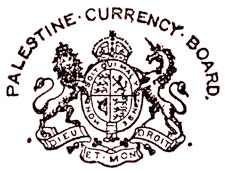 The official stamp of the Palestine Currency Board was actually a drawing of the royal arms with an inscription of the Board’s title.
The official stamp of the Palestine Currency Board was actually a drawing of the royal arms with an inscription of the Board’s title.
It was usual for a body of this nature to use the royal arms in conjunction with its own title; it can also be found in other currency boards.
The official stamp was printed or embossed as headed notepaper and probably also produced as a rubber stamp, to give its correspondence and documents a distinctive and official appearance.
Between 13-15 October, the government published announcements in the post offices around the country depicting for the first time the currency notes and the coins, with a notice specifying the values, sizes and colors.
(Size 498x549 mm).
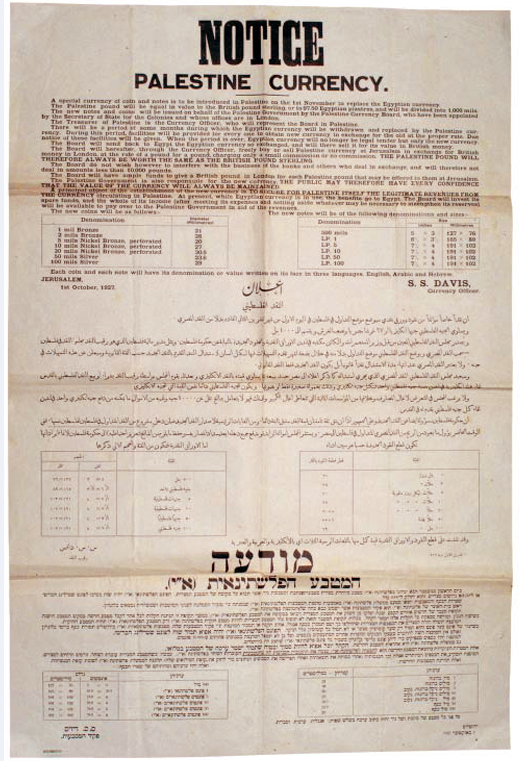
NOTES OF THE PALESTINE CURRENCY BOARD
The currency notes of the Palestine Currency Board were introduced on Monday, 1 November 1927, and included the denominations of 500 mils (£P½), and £P1, £P5, £P10, £P50 and £P100. These were the first currency notes issued for Palestine.
This series of currency notes ended up being the only series, and throughout all the years of the Mandate and the activity of the Currency Board, notes were issued with no changes in design, only the dates and the signatures of Board members.
500 mils מיל (£P½ )
- Size:126x76 mm. / 5x3 inch.
- Color: Brown-purple. Apparently this color was intentionally selected in an effort to make it easier for the public to adjust to the new note .as it was almost identical to that of the widely circulated Egyptian 50 piastres note (£E½).
- Serial No.: Black, six digits, in the obverse lower left-hand corner and upper right-hand corner.
- Prefix: A
- Obverse: Rachel’s Tomb, north of Bethlehem
- Reverse: The Jerusalem Citadel – The Tower of David.
- Remarks:
- On this note as well as on the £P1 note, two dots appear beneath the “st” of the 1st on the date, while on the other denominations of that issue as well as on all the notes of other dates only one dot appears.
- This note was the first reported to have been forged.
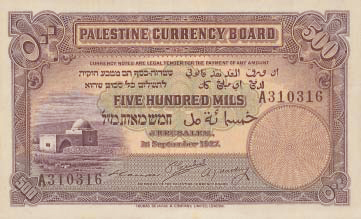
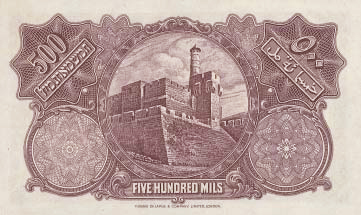
1 Pound (£P1)
- Size:165x89 mm. / 6½x3½ inch.
- Color: Yellow-green. Apparently, as in the case of the 500 mils note, in an effort to make it easier for the public to adjust to the new note this color was chosen to resemble that of the widely circulated Egyptian £E1 note.
- Serial No.: Black, six figures, in the obverse lower-left-hand corner and upper right-hand corner.
- Prefix: A, B
- Obverse: Dome of the Rock, Jerusalem.
- Reverse: The Jerusalem Citadel – The Tower of David.
- Remarks:
- As stated above, on this note two dots appear beneath the “st” of the 1st in the date, while only one dot appears on the other denominations of that issue as well as on all the notes of other dates.
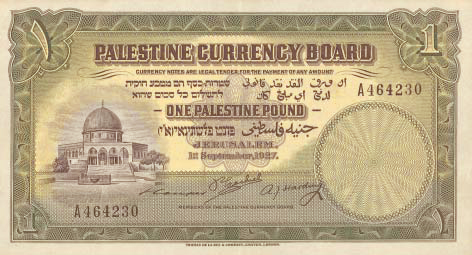
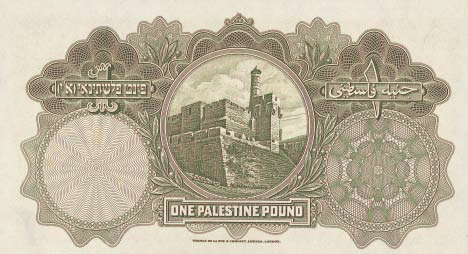
5 pounds (£P5)
- Size:191x102 mm. / 7½x4 inch.
- Color: Red-orange
- Serial No.: Red, six digits, in the obverse lower left-hand corner and upper right-hand corner.
- Prefix: A
- Obverse: The White Tower, Ramleh.
- Reverse: The Jerusalem Citadel – The Tower of David.
- Remarks: Starting with this note, all following notes are similar in size and design.
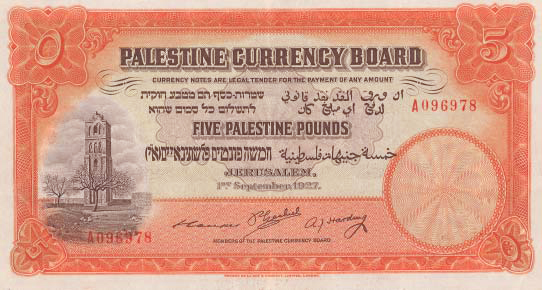
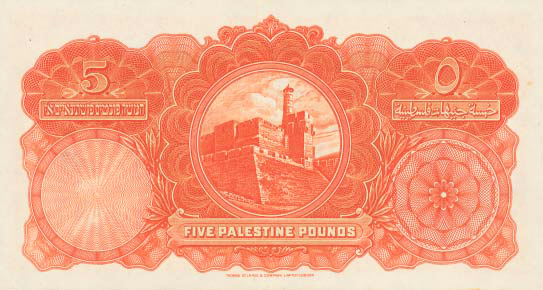
10 Pounds £P10
- Size:191x102 mm. / 7½x4 inch.
- Color: Blue
- Serial No.: Red, six digits, in the obverse lower left-hand corner and upper right-hand corner.
- Prefix: A
- Obverse: The White Tower, Ramleh.
- Reverse: The Jerusalem Citadel – The Tower of David.
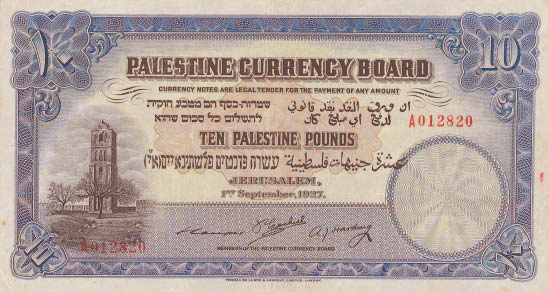
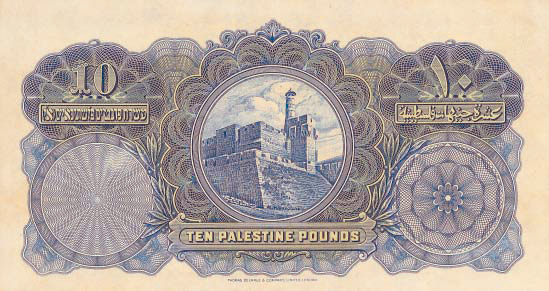
50 Pounds (£P50)
- Size:191x102 mm / 7½x4 inch.
- Color: Purple
- Serial No.: Red, six digits, in the obverse lower left-hand corner and upper right-hand corner.
- Prefix: A
- Obverse: The White Tower, Ramleh.
- Reverse: The Jerusalem Citadel – The Tower of David.
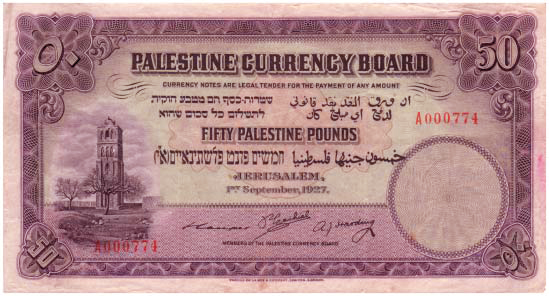
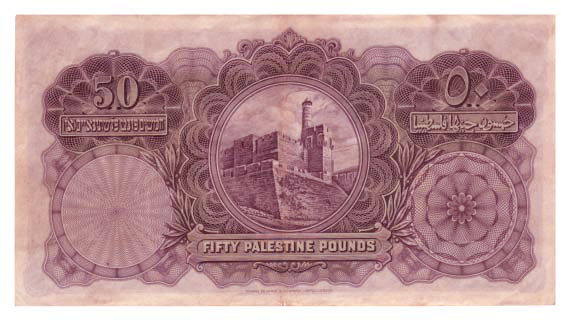
100 Pounds (£P100)
- Size:191x102 mm / 7½x4 inch.
- Color: Green
- Serial No.: Red, six digits, in the obverse lower left-hand corner and upper right-hand corner.
- Prefix: A
- Obverse: The White Tower, Ramleh.
- Reverse: The Jerusalem Citadel – The Tower of David.
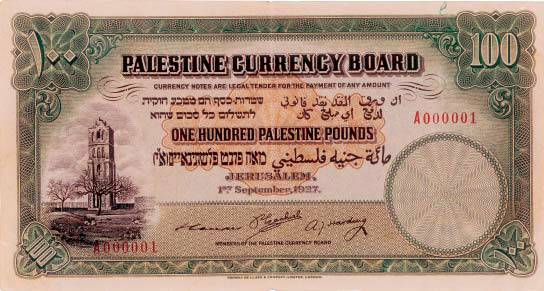
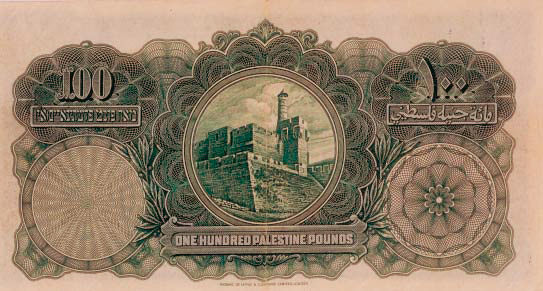
SPECIMEN AND PRESENTATION NOTES
Specimen notes, as their name implies, were intended to serve as samples of the actual notes, and were generally distributed to banking and judiciary institutions, etc., close to the time of first issue, so that they would be known and identified within these contexts.
- specimen notes identical to notes that would eventually circulate, which had the word ‘CANCELLED’ perforated into them, some bearing a serial number comprised of all zeros, and some with a regular serial number;
- presentation notes which were specimen notes printed in different colors from the circulation notes, intended to promote sales and presentations.
Variation 1, type a: 500 mils 1929
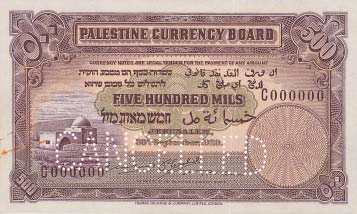
Variation 1, type a: 1 pound 1929
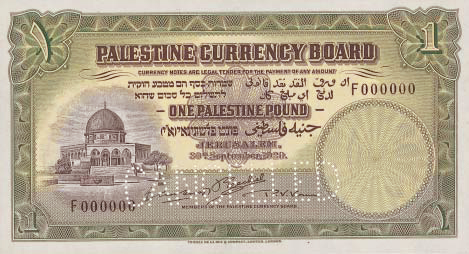
1 Pound (£P1) presentation note of variety 1
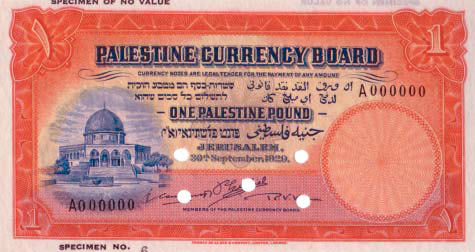
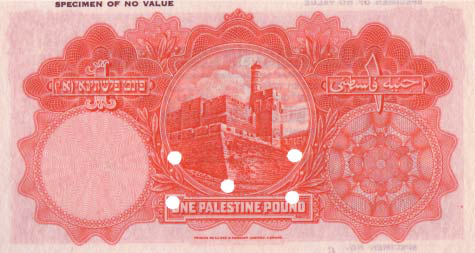
1 Pound (£P1) presentation note of variety 2
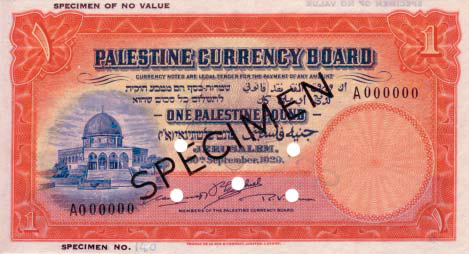
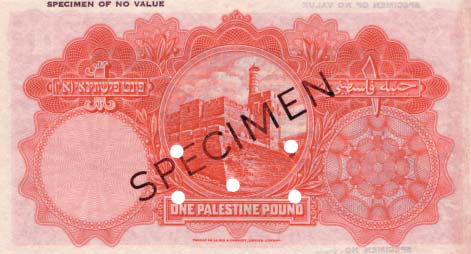
PALESTINE CURRENCY BOARD COUNTERFEIT NOTES
The notes of the Palestine Currency Board were not ignored by the counterfeiters, and at the end of November 1927, only three weeks after their introduction into circulation, counterfeit notes were discovered.
The counterfeits fell into two main categories:
- those forged by criminals, with criminal intent;
- those forged as part of the war effort with two related issues of interest:
- counterfeiting attributed to members of the underground movements during the years 1946-47, as part of the struggle against the Mandatory government;
- suspicion regarding apparent counterfeiting by German intelligence during WWII.
Counterfeit 1939 £P5 serial numbers with no prefix
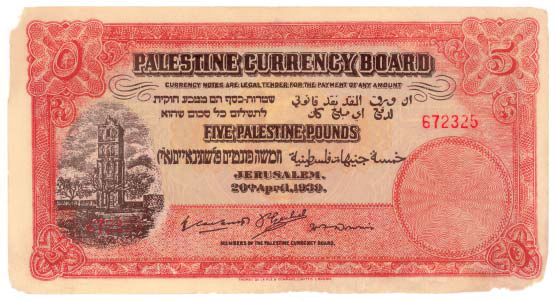
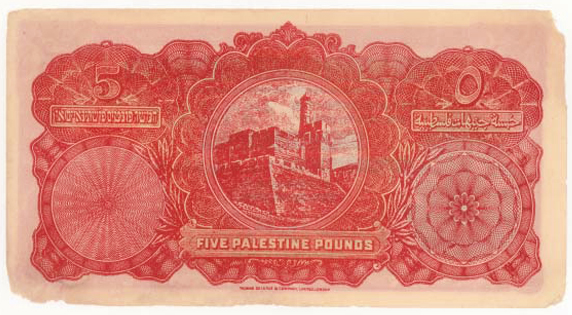
Counterfeit 1939 £P5 serial numbers with a prefix
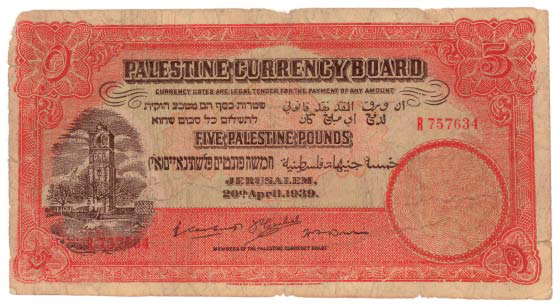
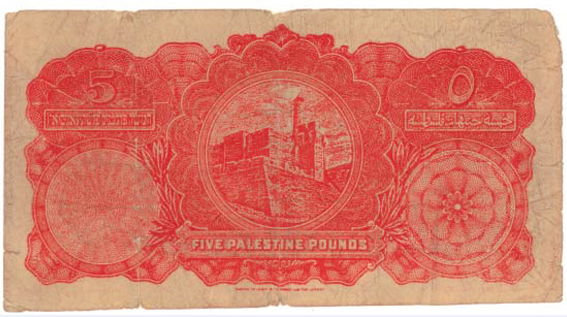
NEW DESIGNS AND COLOUR TRIALS
The topic of new designs and color trials is a complex matter involving the following categories.
- New currency note designs. The discussion of new designs began in 1930, when preparations were being made in anticipation of wide-scale counterfeiting of the notes in circulation, necessitating their replacement.
- Proposals for alternate colors for the notes in circulation. This matter first arose in February 1928 after a similarity was detected between the £P1 note and the Turkish £T1 note, but it was postponed and was brought up again in 1930 with the discussions regarding the new designs.
- The £P5 note with a new design and change of color. This note, which combines the two preceding categories, was approved for issue in May 1947 after many forgeries of this denomination were discovered in circulation.
Obverse proof, £P5. (This design was rejected and so it was not sent to Palestine.)
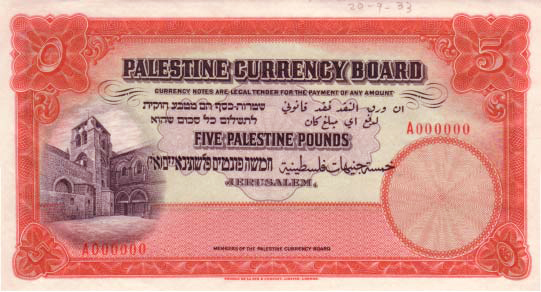
Obverse proof, £P10. (The design was rejected and so was not sent to Palestine.)
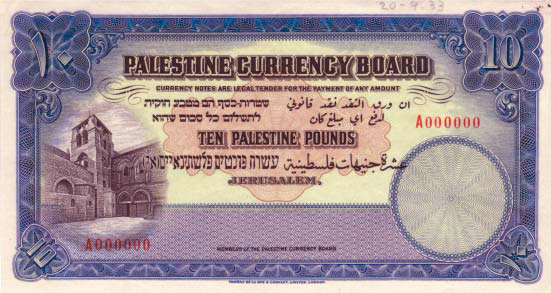
Color trials of the £P1, 1937
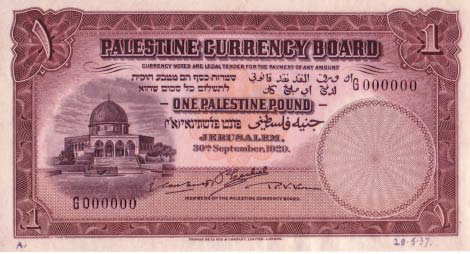
THE UNISSUED WORLD WAR II EMERGENCY NOTES
In 1941, Europe was in the throes of the Second World War; Germany and its allies on the continent were in almost complete control of Europe; the submarines of the German and Italian fleets were in almost exclusive control of the Mediterranean basin. This reality seriously impeded the supply lines from Britain to Palestine (as it did with the supply lines to Cyprus), giving rise to a fear that the reserves of local notes and coins would be exhausted, making it impossible to respond to public demand.
Given the above, two simultaneous initiatives were taken regarding the matter:
- Preparations were made by the Palestine Government Printer for a local printing of notes for denominations of 50 mils and 100 mils in place of the silver coins of that value, and for notes of denominations £P1 and £P50. All the plates were engraved for this purpose by Emil Pikovsky Zincography in Jerusalem.
- An order was sent from the Palestine Currency Board to De La Rue for plates for notes that would solve the problem of the shortage of silver coins of denominations 50 mils and 100 mils, and for the £P1 note.
£P1 Brown proof with orange guilloche under print designed Emil Pikovsky Zincography
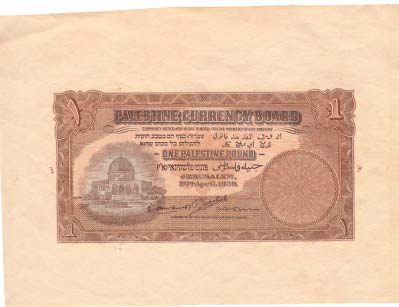
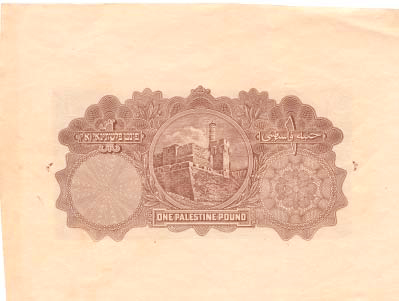
100 mils “COMPLETE PROOF” dated 2/7/43 designed by the printer De La Rue
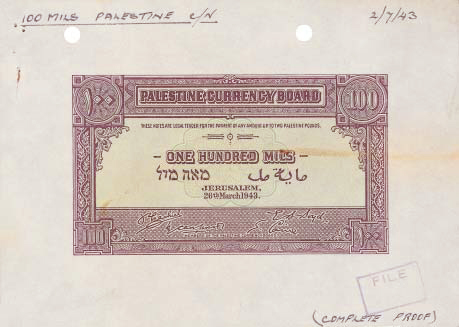
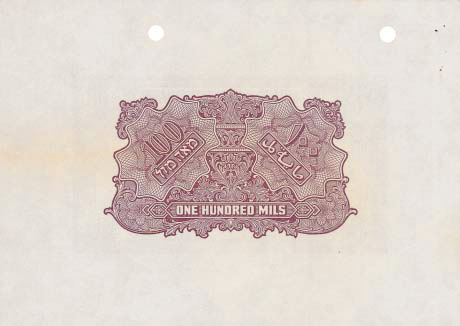
NOTES AND ANECDOTES
The study of thousands of archival documents, perusal of newspapers from the period in question and interviews with people connected with the topic, have uncovered not only much information regarding banknotes of the Palestine Currency Committee, but have also turned up some interesting stories, curiosities, and entertaining tidbits.
Enlarged photograph of the watermark area on the face of the £P50 note A000001 with a dedication handwritten by Mr. Rotenberg to Mr. Ussishkin
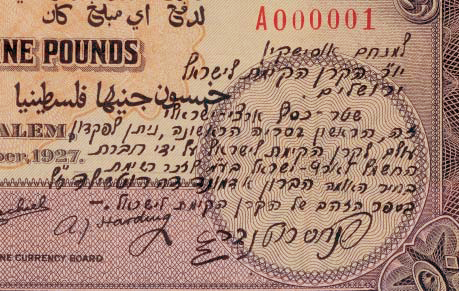
END OF AN ERA
On 29 November 1947 On 29 November 1947 the United Nations voted to partition Palestine and establish two states, a Jewish state and an Arab state, one alongside the other.
At the end of that same year and during the first half of 1948 the Currency Board moved the currency reserves from Palestine to Britain and closed the currency centers across the country.
In the second half of 1948, the currency notes became “Notes without a Country”, and in effect served as legal tender in three separate areas: the State of Israel, Trans-Jordan, and the Gaza Strip, until they were eventually demonetized in 1951.
In 1952 the Palestine Currency Board was dissolved.

